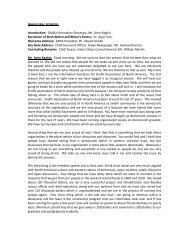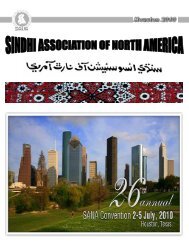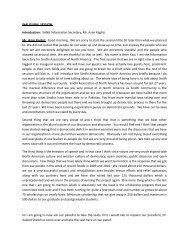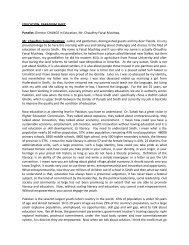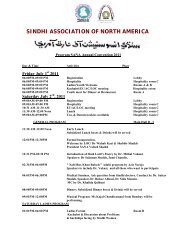Sheedi Community in Sindh, Pakistan - Sindhi Association of North ...
Sheedi Community in Sindh, Pakistan - Sindhi Association of North ...
Sheedi Community in Sindh, Pakistan - Sindhi Association of North ...
You also want an ePaper? Increase the reach of your titles
YUMPU automatically turns print PDFs into web optimized ePapers that Google loves.
In the book <strong>of</strong> ethnography pr<strong>in</strong>ciples <strong>in</strong> practice Pelto said as:<br />
“Even <strong>in</strong> anthropology, where ethnography has always been the staple research<br />
method, a similar, if milder, tendency, to the establishment <strong>of</strong> dist<strong>in</strong>ct research<br />
traditions can be found”<br />
(1978:10)<br />
History <strong>of</strong> anthropology reveals that <strong>in</strong>itially it was based on ethnographic<br />
account <strong>of</strong> different cultures and societies, which were exotic and <strong>in</strong>trigued the<br />
Europeans. Franz Boas first articulated the central place <strong>of</strong> ethnography and its<br />
major tenants <strong>in</strong> United States Bronislaw Mal<strong>in</strong>owski did the same Brita<strong>in</strong>.<br />
Mal<strong>in</strong>owski established a widely, quoted and read example <strong>of</strong> ethnography <strong>in</strong> his<br />
writ<strong>in</strong>g about his two years <strong>of</strong> field work <strong>in</strong> Trobriand Island which he commenced<br />
<strong>in</strong> 1915. Mal<strong>in</strong>owski advocated that anthropologist must spend long time <strong>in</strong> one<br />
place and rema<strong>in</strong> <strong>in</strong> close contact with people. Every day life details should be<br />
collected through m<strong>in</strong>ute detailed observation and should grasp native‟s po<strong>in</strong>t <strong>of</strong><br />
view (Mal<strong>in</strong>owski 1915).<br />
2.2 ETHNOMUSICOLOGY:<br />
The beg<strong>in</strong>n<strong>in</strong>gs <strong>of</strong> ethnomusicology are usually traced back to the 1880s, and<br />
1890s, when studies were <strong>in</strong>itiated primarily <strong>in</strong> Germany and <strong>in</strong> the United<br />
States. Early <strong>in</strong> this development there appeared a dual division <strong>of</strong> emphasis that<br />
has rema<strong>in</strong>ed through history <strong>of</strong> the field.<br />
Encyclopedia <strong>of</strong> <strong>in</strong>ternational social science (1976.p: 562) def<strong>in</strong>es the two polar<br />
positions def<strong>in</strong>itions “ethnomusicology” are most frequently enunciated. The first<br />
is embodied <strong>in</strong> such statement as “ethnomusicology is the total study <strong>of</strong> non<br />
western music,” and the second <strong>in</strong> “ethnomusicology is the study <strong>of</strong> music <strong>in</strong><br />
culture”. The first derives from a supposition that ethnomusicology should<br />
concern itself with certa<strong>in</strong> geographical areas <strong>of</strong> the world; those hold this po<strong>in</strong>t<br />
<strong>of</strong> view tend to treat the music structurally. The second stresses music <strong>in</strong> its<br />
17



